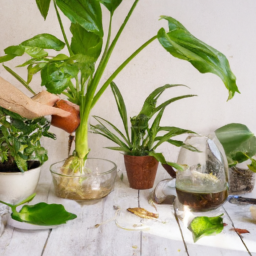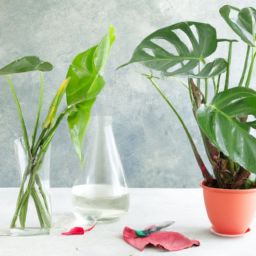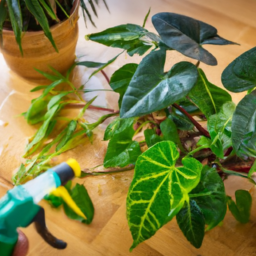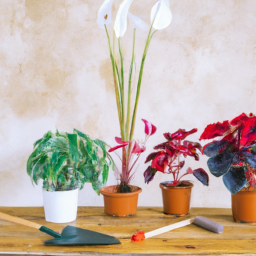
Are you looking to keep your indoor plants healthy and thriving throughout the year? In this blog post, we will discuss the importance of a Year-Round Indoor Plant Care Routine: Essential Tasks for Every Season. Taking care of your indoor plants is not just a one-time task; it requires consistent attention and care to ensure they continue to grow and flourish. By following a routine that caters to the specific needs of your plants during each season, you can help them thrive and bring a touch of nature into your home all year long. Let’s dive into the essential tasks you should incorporate into your indoor plant care routine to keep your plants happy and healthy no matter the season.
The Importance of Consistent Indoor Plant Care Throughout the Year
Introduction
Indoor plants not only add beauty to our homes but also provide numerous health benefits such as purifying the air and reducing stress. However, in order to keep our indoor plants thriving, it is essential to maintain a consistent care routine throughout the year. Each season brings its own challenges and requirements for indoor plant care, so it is important to stay on top of tasks to ensure the health and vitality of your plants.
Understanding the Needs of Indoor Plants
Before delving into the specific tasks for each season, it is important to understand the basic needs of indoor plants. Light, water, humidity, temperature, and nutrients are all essential factors that contribute to the overall health of your plants. Different plant species have varying requirements, so it is important to research the specific needs of each plant in your collection.
Light is one of the most crucial factors for indoor plants, as it is essential for photosynthesis. Most indoor plants require bright, indirect light to thrive, so be sure to place your plants near a window where they can receive adequate light. Watering is another important aspect of plant care, as overwatering or underwatering can lead to root rot or dehydration. It is important to water your plants when the top inch of soil feels dry to the touch.
Humidity levels can also impact the health of your indoor plants, as many plants prefer higher humidity levels. You can increase humidity by misting your plants, placing them on a pebble tray filled with water, or using a humidifier. Temperature is another important factor to consider, as most indoor plants prefer temperatures between 65-75°F during the day and slightly cooler temperatures at night.
Essential Tasks for Every Season
Now that you have a basic understanding of indoor plant care, let’s explore the essential tasks that should be performed throughout the year to keep your plants healthy and thriving.
Spring
As the days get longer and temperatures begin to rise, spring is a time of growth and renewal for indoor plants. This is the perfect time to repot any plants that have outgrown their containers, as well as prune any leggy growth to promote new growth. Be sure to fertilize your plants with a balanced fertilizer to provide them with the nutrients they need for healthy growth.
Spring is also a good time to inspect your plants for pests and diseases, as these issues can quickly spread and damage your plants. If you notice any signs of pests or disease, take action immediately to prevent further damage. Lastly, be sure to increase your watering frequency as the temperatures rise and your plants begin to actively grow.
Overall, spring is a time of rejuvenation for indoor plants, so be sure to give your plants the care and attention they need to thrive during this season.
Summer
Summer is a time of rapid growth for indoor plants, so it is important to stay on top of watering and fertilizing to support this growth. Be sure to water your plants regularly, as the warmer temperatures can cause soil to dry out more quickly. Fertilize your plants every 2-4 weeks with a balanced fertilizer to provide them with the nutrients they need for healthy growth.
Summer is also a good time to increase humidity levels for your plants, as the warmer temperatures can lead to dry air. You can increase humidity by misting your plants, placing them on a pebble tray filled with water, or using a humidifier. Be sure to also inspect your plants regularly for pests and diseases, as these issues can quickly spread in the warm, humid conditions of summer.
Overall, summer is a time of active growth for indoor plants, so be sure to provide them with the care and attention they need to thrive during this season.
Fall
As temperatures begin to cool and days grow shorter, fall is a time of transition for indoor plants. This is a good time to bring any outdoor plants back inside before the temperatures drop too low. Be sure to inspect your plants for pests and diseases before bringing them inside, as you don’t want to introduce any unwanted guests into your home.
Fall is also a good time to reduce watering frequency for your plants, as they will begin to enter a period of dormancy. Be sure to also reduce fertilizing frequency, as your plants will not be actively growing during this time. Lastly, be sure to clean and dust your plants regularly to remove any debris or dust that may have accumulated on their leaves.
Overall, fall is a time of preparation for indoor plants as they enter a period of dormancy, so be sure to give them the care and attention they need to thrive during this season.

Year-Round Indoor Plant Care Routine: Essential Tasks for Every Season
Hello plant lovers! Taking care of your indoor plants throughout the year is essential for their health and growth. Each season brings its own set of challenges and requirements for indoor plant care. In this guide, we will discuss the essential tasks you need to perform for your indoor plants in every season to ensure they thrive all year long.
Spring
As the days get longer and warmer in spring, your indoor plants will start to show signs of new growth. This is the perfect time to repot any plants that have outgrown their containers. Choose a slightly larger pot with good drainage to allow for healthy root growth. Additionally, spring is a great time to start fertilizing your plants. Use a balanced fertilizer to provide essential nutrients for growth.
During spring, it’s important to increase your watering frequency as plants start to actively grow. Check the soil moisture regularly and water when the top inch of soil feels dry. Keep an eye out for pests such as spider mites and aphids, which tend to be more active in warmer weather. Regularly inspect your plants for any signs of infestation and treat them promptly.
Finally, spring is a good time to give your plants a shower. Place them in the sink or bathtub and gently spray them with lukewarm water to remove dust and dirt from the leaves. This will help improve photosynthesis and overall plant health.
Summer
Summer can be a challenging time for indoor plants, as the increased heat and humidity can lead to issues such as overwatering and heat stress. To combat this, make sure to adjust your watering schedule accordingly. Water your plants early in the morning or late in the evening to prevent evaporation and reduce the risk of root rot.
Provide adequate ventilation for your plants by opening windows or using a fan to improve air circulation. This will help prevent fungal diseases and keep your plants healthy. Consider moving your plants away from direct sunlight during the hottest part of the day to prevent sunburn.
Regularly check for signs of nutrient deficiencies such as yellowing leaves or stunted growth. Adjust your fertilizing routine as needed to provide the necessary nutrients for your plants to thrive. Keep an eye out for pests like mealybugs and scale insects, which are more active in warm weather.
Fall
As temperatures start to cool down in fall, your indoor plants will begin to slow down their growth. This is a good time to reduce your watering frequency and allow the soil to dry out slightly between waterings. Be mindful of the decreasing daylight hours and adjust your plant’s placement to ensure they receive enough light.
Inspect your plants for any signs of stress or disease and treat them promptly. Prune any dead or yellowing leaves to encourage new growth. Consider repotting any plants that have become root-bound or are showing signs of decline. Use a well-draining potting mix to prevent waterlogging.
Prepare your plants for the upcoming winter by gradually reducing fertilization. This will help them enter dormancy and conserve energy. Keep a close eye on humidity levels, as indoor heating can lead to dry air. Consider using a humidifier or pebble tray to increase humidity around your plants.
Winter
Winter can be a challenging time for indoor plants, as the lower light levels and dry air can lead to issues such as leaf drop and stunted growth. Place your plants near a south-facing window to maximize sunlight exposure. Consider using grow lights to supplement natural light if needed.
Reduce your watering frequency during winter, as plants tend to go dormant and require less water. Check the soil moisture regularly and water only when necessary. Avoid placing your plants near drafty windows or heating vents, as sudden temperature changes can stress them.
Monitor your plants for pests such as whiteflies and spider mites, which are common in indoor environments during winter. Keep a close eye on humidity levels and consider misting your plants occasionally to increase moisture in the air. Insulate your plants from cold drafts and consider using a plant heater to maintain optimal temperatures.

Tips for Creating a Year-Round Indoor Plant Care Routine to Keep Your Plants Healthy and Thriving
Understanding the Importance of Consistent Care
Taking care of indoor plants is not just a seasonal task, but a year-round commitment. In order to keep your plants healthy and thriving, it is essential to create a consistent care routine that addresses the specific needs of each plant. Consistency is key when it comes to indoor plant care, as fluctuations in temperature, light, and humidity can have a negative impact on plant health.
One of the most important aspects of indoor plant care is understanding the specific needs of each plant species. Different plants have different requirements when it comes to light, water, and humidity levels. By taking the time to research the specific needs of each plant in your collection, you can ensure that they receive the proper care they need to thrive.
Another important aspect of indoor plant care is regular monitoring. By regularly checking on your plants, you can catch any issues early on and address them before they become serious problems. This includes checking for signs of pests, disease, or nutrient deficiencies, as well as monitoring the overall health and growth of your plants.
Consistent care also involves regular maintenance tasks, such as pruning, repotting, and fertilizing. By staying on top of these tasks throughout the year, you can help your plants stay healthy and vibrant. Additionally, creating a consistent watering schedule is crucial for indoor plant care, as overwatering or underwatering can lead to serious issues such as root rot or dehydration.
Seasonal Care Tasks for Indoor Plants
While consistent care is important year-round, there are specific tasks that should be done in each season to ensure the health and vitality of your indoor plants. In the spring, it is important to repot any plants that have outgrown their containers, as well as to fertilize them to support new growth. Spring is also a good time to prune any leggy or overgrown plants to encourage bushier growth.
In the summer, it is important to monitor your plants for signs of heat stress, such as wilting or yellowing leaves. Providing adequate ventilation and humidity levels can help prevent heat stress in your plants. Additionally, summer is a good time to increase watering frequency, as plants tend to dry out more quickly in the warmer months.
In the fall, it is important to start preparing your plants for the lower light levels and cooler temperatures of winter. This may involve moving plants closer to windows to maximize light exposure, as well as reducing watering frequency to account for the lower levels of evaporation. Fall is also a good time to inspect your plants for pests and disease, as these issues tend to be more prevalent in the cooler months.
In the winter, it is important to adjust your care routine to account for the lower light levels and cooler temperatures. This may involve reducing watering frequency, as plants tend to go dormant in the winter and require less water. Additionally, it is important to monitor humidity levels in the winter, as indoor heating can lead to dry air that can be harmful to plants.
Troubleshooting Common Indoor Plant Care Issues
Despite your best efforts, you may encounter issues with your indoor plants from time to time. Common issues include yellowing leaves, wilting, pests, and disease. When faced with these issues, it is important to act quickly to address the problem and prevent it from spreading to other plants.
Yellowing leaves are often a sign of overwatering, nutrient deficiencies, or poor light exposure. To address this issue, adjust your watering schedule, fertilize your plants, and move them to a location with better light exposure. Wilting can be caused by underwatering, heat stress, or root rot. To address wilting, adjust your watering schedule, provide adequate ventilation, and check for signs of root rot.
Pests such as spider mites, aphids, and mealybugs can wreak havoc on indoor plants if left unchecked. To address pest issues, isolate affected plants, prune away heavily infested areas, and treat with insecticidal soap or neem oil. Disease issues such as powdery mildew or root rot can be caused by poor air circulation, overwatering, or high humidity levels. To address disease problems, improve air circulation, adjust your watering schedule, and reduce humidity levels.
By creating a year-round indoor plant care routine that addresses the specific needs of your plants and includes regular monitoring and maintenance tasks, you can help ensure the health and vitality of your indoor plant collection. Consistency is key when it comes to indoor plant care, so be sure to stay on top of your care routine throughout the year to keep your plants healthy and thriving.
Summary Snapshot
Taking care of indoor plants is a year-round commitment that requires attention to detail and consistency. Each season brings its own set of challenges and tasks to keep your plants healthy and thriving. In the spring, it’s important to repot any plants that have outgrown their containers and fertilize them to encourage new growth. Summer calls for regular watering and ensuring your plants receive enough sunlight without overheating. Fall is the time to prepare your plants for winter by bringing them indoors and adjusting their care routine accordingly.
As winter approaches, it’s crucial to monitor the humidity levels in your home and provide extra insulation for your plants to protect them from the cold. Throughout the year, it’s essential to regularly check for pests, dust your plants’ leaves, and prune them as needed to promote healthy growth. By staying on top of these essential tasks for every season, you can create a thriving indoor plant oasis that brings beauty and tranquility to your home year-round.
Check Out These FAQs:
Q1: What are some essential tasks for year-round indoor plant care?
A1: Some essential tasks for year-round indoor plant care include watering regularly, checking for pests, repotting when necessary, and providing adequate sunlight.
Q2: How often should indoor plants be watered?
A2: Indoor plants should be watered when the top inch of soil feels dry to the touch. The frequency of watering may vary depending on the type of plant and the season.
Q3: How can I prevent pests from infesting my indoor plants?
A3: To prevent pests from infesting your indoor plants, regularly inspect the leaves and stems for any signs of pests. You can also use natural remedies like neem oil or insecticidal soap to control pests.
Q4: When should indoor plants be repotted?
A4: Indoor plants should be repotted when they become root-bound, meaning the roots have outgrown the current pot. This is typically done every 1-2 years, depending on the plant’s growth rate.
Q5: How can I ensure my indoor plants receive enough sunlight throughout the year?
A5: To ensure your indoor plants receive enough sunlight, place them near a window where they can get indirect or filtered sunlight. Rotate the plants occasionally to promote even growth on all sides. Consider using grow lights during the winter months when natural sunlight may be limited.

James Wong is a renowned ethnobotanist, plant scientist, and local television presenter. With a passion for demystifying plant science, he is known for translating complex botanical concepts into practical advice for everyday plant enthusiasts. James’s expertise spans from traditional gardening to cutting-edge plant technologies, making his insights accessible and informative.


